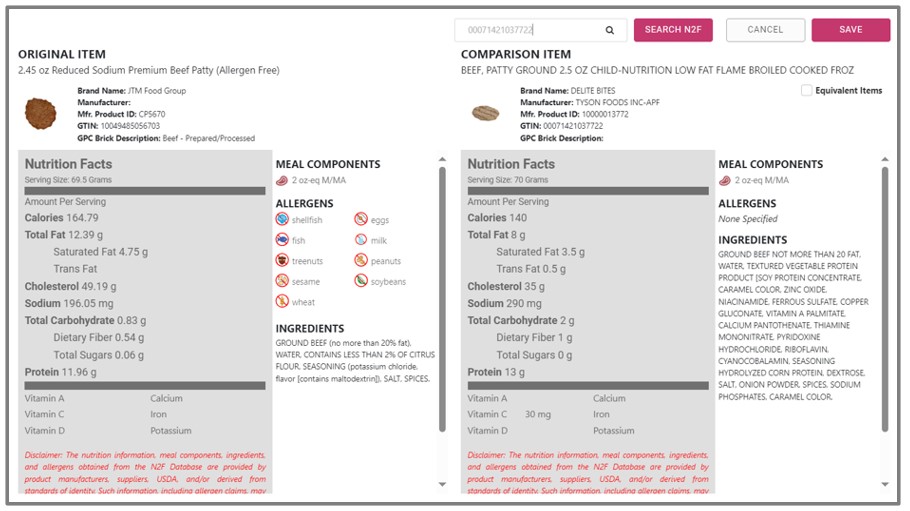“Bidding by GTIN”
Guidance Materials
Guidance materials published over the past several months by USDA, SNA, and ACDA have all recognized the complexity and ambiguities of current federal competitive procurement regulations. Each has acknowledged the value of the Global Data Synchronization Network (GDSN) standardized data in streamlining the procurement process for multiple stakeholders.
USDA Menu Planner for School Meals Chapter 5 Procurement
“The Global Trade Item Number (GTIN) is to food service what the UPC is to retail groceries. Your procurement program should request GTIN technology during the solicitation process.”
SNA Supply Chain Summit Report 2023
“Improved use of technologies can provide templates, standardization, more suitable timelines and greater accuracy throughout the procurement process. Greater adoption of current GTINs (Global Trade Item Numbers) and the GDSN (Global Data Synchronization Network) is a good place to start.”
ACDA Processing Committee White Paper
“What if further processed end items containing USDA Foods had attributes in the GDSN specific to the USDA code and School Year values in pounds and dollars? A Processor’s Summary End Product Data Schedule (SEPDS) is an existing published document containing these attributes. This could significantly improve menu planning, forecasting, and procurement processes.”
In addition to the white paper, ACDA is actively addressing deeper integration of GDSN for further processed end products, including conducting a series of webinars titled The Future of Bidding.
“Cut and Paste” Examples
This page contains important information to help K-12 Operators navigate through the competitive procurement process in a more efficient manner. Examples of GDSN related content from Texas ESC Region 10 MRPC (R10MRPC) procurement documents is included below.
CFR Competition Requirements
Most districts specify a brand name and “or equivalent” to comply with the competition requirements as defined here:
“When it is impractical or uneconomical to make a clear and accurate description of the technical requirements, a “brand name or equivalent” description may be used to define the performance or other salient requirements of procurement.” CFR 200.319 (d)(1)
In this example, the buyer is signaling a strong preference for a specific item, requesting prospective distributors to shop for quotes with the manufacturer’s bid desk. This may favor one distributor over another and/or require a new (sometimes duplicative) SKU to be added. In some cases, manufacturers will take a higher markup when confident there is no real competition.
Some state agencies have interpreted the regulation differently requiring procuring agencies to describe “technical requirements” without specifying a specific brand or manufacturer product code. In this scenario, a very generalized spec may lead to lower quality products and a very time consuming process of writing “generic” specifications.
Competition can be optimized using industrywide standards and the common language of the Global Data Synchronization Network (GDSN) contained in the Nourish to Flourish Database (N2F). Access to advanced search features using GDSN Connect makes finding and pre-approving competitive equivalents a manageable task.
Side by Side Comparison Feature
When vendors suggest equivalent products that were not pre-approved (and provide the required GTIN data), objective side by side comparisons of published attributes can be made.

Example Co-Op GTIN Requirements – Texas ESC Region 10 MPRC
With 270 member districts and annual purchasing volume exceeding $200 M, Texas ESC Region 10 MPRC (R10MPRC) has pioneered boilerplate language establishing “bidding by GTIN.” Now in its second year, the following language is included in every procurement. R10MRPC’s pioneering efforts have helped bring hundreds of K-12 Suppliers and several software companies into the mainstream of data sharing using GDSN.
Published Specifications, Essential Characteristics, & Salient Requirements
Awarded vendors are required to utilize the GDSN and provide GTIN’s in the bid response to allow R10MRPC members access to up-to-date nutritional information. R10MRPC has prepared this procurement document to address the requirements of CFR 200.319 by adopting the industry wide standards for product registration within the published procedures and protocols of the Global Data Synchronization Network® (GDSN®).
When appropriate, specific brand name products have been identified in Attachment A and in the Bid Table by including a Global Trade Identification Number (GTIN), and a related published specification showing the essential characteristics of that product thereby defining each products salient requirements
- R10MRPC, wherever possible, will pre-approve one or more “equivalent” brand name products from different manufacturers with similar published GTIN specifications.
- Offerors may propose alternative products by providing the GTIN and values for the explicitly identified essential characteristics identified on Attachment A, which will be considered by R10MPRC. Alternative offers may also be subject to blind taste testing before approval at R10MRPC’s discretion.
- Offerors will be notified of acceptance or rejection of proposed alternative products if awarded.
Unbranded Products
Non-brand name products are not required to be registered with GDSN. The links below are references for labeling and common names: Code of Federal Regulations Title 21 Parts 100 – 190: Standard of Identity (SOI) Common Names and Labeling References: CFR Title 21 FDA Part 145 – Canned Fruits. Additional Labeling Guidance: FDA Food Labeling Guide or USDA AMS Grades and Standards: AMS USDA Grades & Standards
R10MRPC Vendor Product Registration Requirement
Here is suggested language for prospective vendors to acknowledge and comply with GDSN requirements to participate in MRPC’s procurements:
R10 MRPC Vendor Registration GDSN Requirement Registration Form
